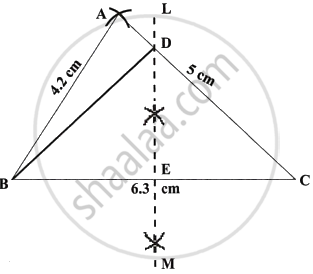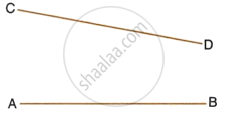Advertisements
Advertisements
प्रश्न
Construct a triangle ABC, in which AB = 4.2 cm, BC = 6.3 cm and AC = 5 cm. Draw perpendicular bisector of BC which meets AC at point D. Prove that D is equidistant from B and C.
उत्तर
Given: In triangle ABC, AB = 4.2 cm, BC = 6.3 cm and AC = 5 cm

Steps of Construction:
- Draw a line segment BC = 6.3 cm
- With centre B and radius 4.2 cm, draw an arc.
- With centre C and radius 5 cm, draw another arc which intersects the first arc at A.
- Join AB and AC. ΔABC is the required triangle.
- Again with centre B and C and radius greater than 12 BC, draw arcs which intersects each other at L and M.
- Join LM intersecting AC at D and BC at E.
- Join DB.
Proof: In ΔDBE and ΔDCE
BE = EC ...(LM is bisector of BC)
∠DEB = ∠DEC ...(Each = 90°)
DE = DE ...(Common)
∴ By side angle side criterion of congruence, we have
ΔDBE ≅ ΔDCE ...(SAS postulate)
The corresponding parts of the congruent triangle are congruent
∴ DB = DC ...(C.P.C.T.)
Hence, D is equidistant from B and C.
APPEARS IN
संबंधित प्रश्न
In parallelogram ABCD, side AB is greater than side BC and P is a point in AC such that PB bisects angle B. Prove that P is equidistant from AB and BC.
Draw a line AB = 6 cm. Draw the locus of all the points which are equidistant from A and B.
In the figure given below, find a point P on CD equidistant from points A and B.

Describe the locus of the centre of a wheel of a bicycle going straight along a level road.
Describe the locus of a stone dropped from the top of a tower.
Describe the locus of a runner, running around a circular track and always keeping a distance of 1.5 m from the inner edge.
In Δ ABC, the perpendicular bisector of AB and AC meet at 0. Prove that O is equidistant from the three vertices. Also, prove that if M is the mid-point of BC then OM meets BC at right angles.
Find the locus of the centre of a circle of radius r touching externally a circle of radius R.
Find the locus of points which are equidistant from three non-collinear points.
ΔPBC and ΔQBC are two isosceles triangles on the same base BC but on the opposite sides of line BC. Show that PQ bisects BC at right angles.
